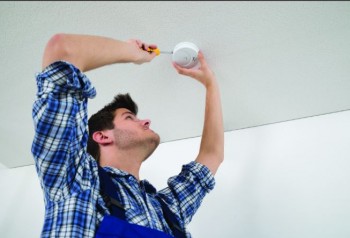Heat and Smoke Detectors: The Latest Trends and Tech
Installing heat and smoke detectors continues to be a steady job. Find out how to stoke customers’ flames of approval by including the latest tech and addressing requests and logistical concerns.

Read on for the latest developments in heat and smoke detection.
Addressing Low Frequency Alarms/Intelligibility
Beginning in 2014, all commercial and certain residential sleeping spaces require the installation of 520Hz sounders for enhanced intelligibly. Research has shown that an alarm at 520Hz is more likely to wake people up compared to the standard 3kHz signal.
Low frequency 520Hz sounder bases are available from a variety of manufacturers such as Siemens, Edwards and Notifier. While NFPA 72 exempts certain areas from requiring having intelligible voice, some businesses in large buildings may request detectors in those areas regardless.
“A lot of times we have corporate clients who have a corporate office and want voice evacuation in the toilet rooms, not just a strobe. Or even in conference rooms,” says Brom. “Per code, there should be enough sound pressure coming from a device in the hallway. But you know, if you’re sitting down and something bad happens, maybe you want a little more intelligibility in the restrooms and conference rooms as well.”
Integration Opens More Doors
The Internet of Things (IoT) has engulfed all things electronic. From light-bulbs and refrigerators, to doorbells and garage doors, almost anything can now be controlled at the touch of a smartphone.
So it should come as no surprise that security integrators can do the same with smoke detectors. More and more companies are putting out products that can be integrated with smart home ecosystems.
In addition to the ability to connect to Philips Hue bulbs, the SkyBell HD video doorbell and Lutron smart shades, the Nest Protect can gain a host of new integrations through IFTTT, for example.
IFTTT is a free web-based service that essentially allows users to create their own simple code, or “applets,” enabling them to incorporate additional alerts and customizations.
Besides the convenience of an Inter-net-connected device, it can also provide a lifesaving purpose. For instance, a customer who is deaf could benefit from a smart smoke detector that is integrated with their smart lightbulbs to strobe in the event of an emergency.
But you don’t need a smart home to take advantage of Internet-connected detectors; commercial offers opportunities for IP-intrepid integrators as well.
“A lot of fire alarm manufacturers are now making Internet communicators available. So all you need is a network drop and an address and you can monitor the fire alarm system via the Internet or IP protocol,” says Brom. “Notifier has web servers where you can use an Internet connection to connect your fire alarm system. So you can have a building engineer or security personnel see what’s going on with their fire alarm system on their smartphone.”
When a customer wants to integrate the systems in their building, smoke and fire detection is always a key piece of the pie.
“A lot of times through BACnet communication, fire alarm data will be provided to building automation systems or process control systems,” Brom says. “There are all kinds of network ability that’s happening with fire alarm systems. It might be tied to security systems and building automation systems and that’s another thing we’re seeing, other systems are asking for the fire alarm contract to provide information in terms of what’s going on on the facility or campus.”
Siemens’ Ouimette notes that being able to remotely access a fire system over a network allows for easier maintenance and diagnostics. You can assess the urgency of the problem, determine exactly what the problem is and prepare a fix prior to visiting the site or in some cases, the ability to correct remotely
Key Additions to the 2016 NFPA 72
SSI enlisted Fire Side Chat columnist and NFPA 72 guru Shane Clary to highlight new verbiage integrators should keep in mind from the 2016 edition of NFPA 72:
3.3.121.1 Mechanically Powered, Single-Station Heat Alarm. A single-station heat alarm employing a mechanical power source.
3.3.241 Response Time Index (RTI). A numerical value that represents the thermal response sensitivity of the sensing element in a heat detector, sprinkler, or other heat-sensing fire detection device to the fire environment in terms of gas temperature and velocity versus time.
7.5.7.1.2 The passwords provided shall enable certified qualified programming personnel to access, edit, modify, and add to the existing system site-specific software.
7.7.2.6 The building owner or the building owner’s representative shall, on an annual basis, review any electronic documentation media formats and associated interfacing hardware for compatibility and update, if necessary.
10.11.3 Visible alarm strobe notification appliances shall not be activated when speaker notification appliances are used as permitted by 24.3.5 for non-emergency paging.
14.2.2.2.4 In the event that any equipment is observed to be part of a recall program, the system owner or the system owner’s designated representative shall be notified in writing.
Table 14.4.3.2 Line 4(f) Where shared communications equipment is used as permitted by 26.6.3.1.14, provided secondary (standby) power sources shall be tested in accordance with Table 14.4.3.2, Sections 7, 8 or 9 as applicable.
23.6.2 Class N Devices. No area or zone shall be serviced solely by a single device where Class N pathways are deployed, such that a single device failure would render an area or zone incapable of initiating input signals or receiving output signals.
Exception: When a risk analysis is performed to determine areas where a single device is sufficient and acceptable to the authority having jurisdiction.
READ NEXT: Global Fire Protection Systems Market Growing 8.8% Annually, Report Says
If you enjoyed this article and want to receive more valuable industry content like this, click here to sign up for our FREE digital newsletters!

Security Is Our Business, Too
For professionals who recommend, buy and install all types of electronic security equipment, a free subscription to Commercial Integrator + Security Sales & Integration is like having a consultant on call. You’ll find an ideal balance of technology and business coverage, with installation tips and techniques for products and updates on how to add to your bottom line.
A FREE subscription to the top resource for security and integration industry will prove to be invaluable.








